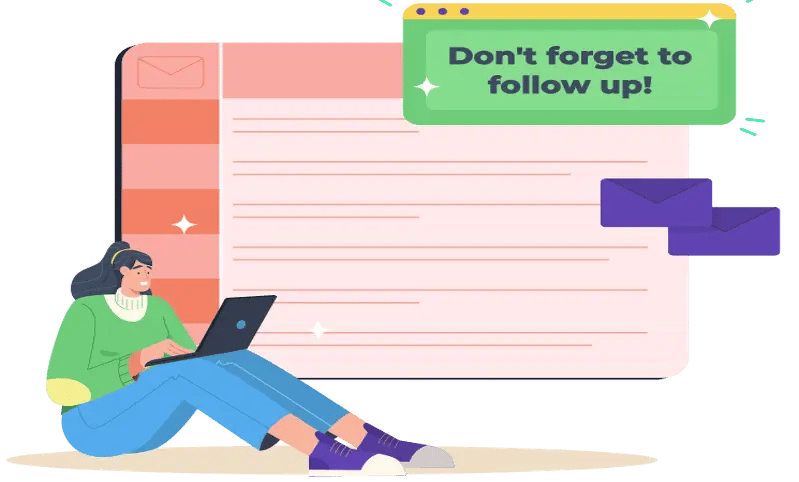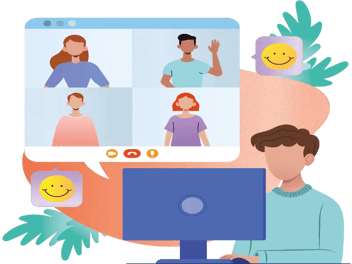How is Your Webinar Follow-Up? Best Practices to Maximize Impact
Webinars are a powerful tool for businesses to educate and engage with their audience, but what happens after the webinar? Following up with attendees is crucial for building relationships and converting them into customers. While you promote your webinar beforehand, not following up effectively is leaving potential leads on the table.
From crafting effective follow-up emails to nurturing leads with drip campaigns, explore actionable tips for each stage of the follow-up process.
Only 42% of marketers follow up with webinar attendees within 24 hours. Following up with your webinar attendees is an immediate way to stand out against competitors.
Preparing for Follow-Up
Following up with webinar attendees requires planning and preparation to ensure the right message reaches the right people at the right time. You can't just jump in feet first and send a mass email to all attendees. Instead, follow these steps before following up with your attendees post-webinar:
Plan Ahead
The first step in preparing for follow-up is to plan. Consider the goals of your webinar marketing and what actions you want attendees to take after the event. For example, if you're promoting a product or service, your goal may be to convert attendees into customers. Or, if you're using the webinar for lead generation, your goal may be to nurture those leads and move them through the sales funnel.
Once you've established your goals, consider the types of follow-up you'll use, such as email, social media, or phone calls. Each method has its strengths and weaknesses; you should choose the ones that best fit your goals and your audience.
Segment Your Audience
Segmenting your audience is critical for targeted follow-up. By dividing attendees into groups based on their interests, behavior, or demographics, you can send personalized messages more likely to resonate with them.
There are many ways to segment your audience, such as by industry, job title, or buying stage. You can also segment based on how attendees engaged with your webinar, such as whether they attended the entire session or left early. By segmenting your audience, you can tailor your follow-up messages to their needs and interests, increasing engagement and conversions.
Now, let's dive into how to follow up with your attendees.
Nurturing Leads with Drip Campaigns
Drip campaigns are a powerful way to nurture and move leads through the sales funnel. A drip campaign is a series of automated emails sent over a period of time, with each email designed to build on the previous one and provide more value to the recipient.
1. Define Your Goals
The first step in creating a drip campaign is to define your goals. What do you want to achieve with the campaign? Do you want to drive conversions, increase engagement, or provide more information to your leads? Defining your goals will help you create a campaign tailored to your needs.
2. Segment Your Audience
Segmentation is critical to effective drip campaigns. You can create more targeted and personalized campaigns by dividing your audience into smaller groups based on their behavior or interests. For example, you could segment your audience based on the sessions they attended during the webinar or the questions they asked.
3. Map Out Your Campaign
Once you've defined your goals and segmented your audience, it's time to map out your campaign. Decide on the number of emails you want to send and the intervals between them. Each email should build on the previous one and provide more value to the recipient.
4. Create Compelling Content
The success of your drip campaign will depend mainly on the quality of your content. Use the insights you gained from the webinar to create highly relevant and engaging content. Use a mix of educational content, case studies, and promotional offers to keep your leads engaged and moving through the funnel.
5. Use Marketing Automation Tools
HubSpot's marketing automation tools can help you create and manage your drip campaign. The tools allow you to automate the email-sending process, track the performance of your campaign, and adjust your strategy based on the data. HubSpot's AI-powered tools can also help you personalize the content and optimize your emails for better engagement and conversions.
Crafting Effective Follow-Up Emails
Follow-up emails are one of the most effective ways to engage with webinar attendees and move them through the sales funnel (and, thanks to automation and content tools, usually the easiest). So, how do you craft an effective follow-up email?
1. Start with a Strong Subject Line
The subject line is the first thing attendees will see when they receive your email, so making it attention-grabbing and relevant is critical. Use a clear and concise subject line that highlights the value of your message and encourages attendees to open your email. A subject line like "Thanks for attending our webinar - here's what's next" is more likely to get attention than a generic subject line like "Webinar Follow-Up."
2. Personalize Your Message
Personalization is key to effective follow-up emails. You can use the attendees' names and any other relevant information you have, such as the topics they were interested in during the webinar or the questions they asked. You can also use HubSpot's AI-powered content creation tool to automatically generate personalized content, based on attendee behavior and interests.
.
3. Provide Value
Attendees are likelier to engage with your follow-up emails if they provide value. You can use your follow-up email to provide additional resources related to the webinar topic, such as whitepapers, case studies, or blog posts. You can also offer exclusive discounts or promotions to incentivize attendees to take action. It's also helpful to provide a recorded version of your webinar so attendees can re-watch it in case they missed anything.
4. Include a Clear CTA
A clear call to action (CTA) is essential for driving conversions. Use a clear and actionable call to action that encourages attendees to take the next step, such as scheduling a demo or signing up for a free trial. Make it easy for attendees to take action by including a prominent button or link in your email.
If you're still stuck on the writing aspect of your follow-up email---don't worry. When crafting follow-up emails for webinar attendees, using HubSpot's Content Assistant can help you optimize the content for better performance. By analyzing the email content, the tool can suggest relevant keywords, ensure proper use of grammar and spelling, and provide readability and tone analysis.
Moreover, the Content Assistant can help ensure that the email follows best practices for email marketing, such as using a clear and concise subject line, a personalized greeting, and a compelling call-to-action.
Leveraging Social Media for Follow-Up
Social media is an excellent platform for engaging with your audience and nurturing relationships with potential customers. Here's how to leverage social media to follow up with webinar attendees:
1. Share the Webinar Recording
Sharing the webinar recording on social media is a great way to engage with attendees and those who may have missed the event. By sharing the recording, you're providing value to your audience and encouraging them to engage with your brand.
2. Highlight Key Takeaways
Use social media to highlight key takeaways from the webinar. Share quotes, statistics, or insights that resonated with attendees and provide additional context or commentary. This will help keep the conversation going and encourage attendees to engage with your brand on social media.
3. Respond to Comments and Questions
You can engage with attendees on social media by responding to comments and questions. This will help to build a relationship with your audience and show that you value their input and feedback. Responding promptly and helpfully will also help to build trust and credibility with your audience.
4. Share Additional Resources
You can use social media to share additional resources related to the webinar. This could include blog posts, white papers, or case studies. By providing valuable resources to your audience, you demonstrate your expertise and establish your brand as a thought leader in your industry.
5. Use Paid Advertising
Consider using paid advertising on social media to reach a wider audience and promote your follow-up content. You can target your advertising to specific demographics or interests to ensure the right people see your content.
Bonus tip: HubSpot's social media management tools can help you manage your social media presence and track the performance of your campaigns. You can schedule posts in advance, monitor social media activity, and track engagement and conversion metrics.
Follow-up With Phone Calls
While email and social media are great tools for following up with webinar attendees, sometimes a phone call can be the most effective way to nurture a lead. However, it's important to be mindful that many people may not be receptive to cold calls.
If you are going to follow up with a phone call, it's essential to have a clear objective and a script prepared. You should also ensure that you are calling at an appropriate time and that the person you call is expecting your call. This will help to ensure that your call is productive and doesn't come across as intrusive or unwelcome.
Consider sending a personalized video message or scheduling a call in advance as an alternative to cold calling. This can help to build rapport with the lead and increase the chances that they will be receptive to your message.
Tracking and Analyzing Follow-Up Results
Tracking and analyzing the results of your follow-up efforts is crucial to understanding what's working and what's not. You can make data-driven decisions about optimizing your follow-up strategy by monitoring key webinar metrics such as open, click-through, and conversion rates.
One effective way to track your follow-up results is using a CRM (customer relationship management) system like HubSpot. A CRM system can help you keep track of your contacts, segment your audience, and track engagement and conversion metrics. This can help you identify trends and patterns in your follow-up data and adjust as needed.
Another critical aspect of tracking and analyzing follow-up results is setting goals and benchmarks for success. By defining what a successful webinar campaign means for your follow-up strategy and regularly measuring your progress against those benchmarks, you can ensure that you're on track to achieving your goals and objectives.
Following up with attendees is critical to a webinar marketing strategy. By preparing for follow-up, crafting effective emails, nurturing leads with drip campaigns, leveraging social media, and using phone calls judiciously, you can build strong relationships with potential customers and move them further down the sales funnel. By tracking and analyzing your follow-up results, you can make data-driven decisions and continuously improve your strategy over time.
This content is also available in:
- Deutsch: Effektives Webinar-Follow-up und Leadgenerierung. So geht's!
- Español: ¿Seguimiento Post-Webinar? Mejores prácticas para maximizar el impacto
- Français: Suivi de webinaire: maximisez l'impact. Meilleures pratiques.
- Italiano: Follow-up webinar: massimizza l'impatto. Le migliori pratiche.
- Română: Urmărirea Webinarului: Cum să Maximizați Impactul și Conversiile
- 简体中文: 您的网络研讨会后续工作如何?最大化影响的最佳做法











.webp?width=352&name=Blog_WBM_Creating%20a%20Killer%20Webinar%20Presentation%20Tips%20and%20Best%20Practices%20(1).webp)
Leave a Comment